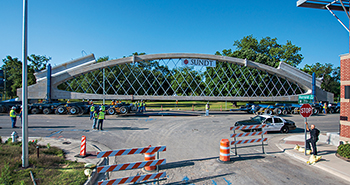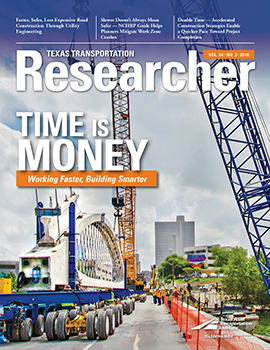ENCOUNTERING the same construction zones day after day, month after month, it’s only natural for travelers to ask “Why does this have to take so long?” Thanks to a growing reliance on creative thinking, it no longer does.

That thinking is at the root of accelerated construction, an effort launched in Texas in 1998 and picking up steam ever since. Increasing funding for roadways has helped promote accelerated-construction techniques, which aim to trim at least 10 to 20 percent — in some cases up to half — from customary project timeframes.
In large part, those techniques are an answer to the blistering pace of growth in Texas. More people driving more cars and trucks place an ever-growing burden on our already strained transportation network. And traditional ways of doing things won’t get the job done.
Two projects — one completed and another about to transition to a new phase — provide examples of how operating agencies can transform how they deliver mobility improvements. In both cases, accelerated construction is more than just a good idea. It’s an economic imperative.
West 7th Street Bridge, Fort Worth, Texas
The West 7th Street Bridge is the primary link connecting downtown Fort Worth, the city’s museum and cultural district, and Trinity Park. In 2013, the 99-year-old bridge had major structural safety concerns and was beyond rehabilitation.

The Texas Department of Transportation (TxDOT), the City of Fort Worth, Sundt Construction, and the Texas A&M Transportation Institute (TTI) partnered to form the West 7th Street Bridge Coalition to facilitate the bridge-replacement effort.
A window of only five months was given to the contractor. “Considering innovative approaches was critical to maintaining local cultural and tourism events, which are important to the local economy,” explains TTI Research Engineer Scott Cooner.
One innovative approach involved fabricating the concrete bridge arches at a nearby site, and using the same size arches for the entire bridge. Each arch cost approximately $1 million and weighed 290 tons. Once the first arch was created, fabrication of the remaining arches moved more quickly. The arches were transported to the rebuilding site using a mode normally reserved for maneuvering heavy equipment to oil-drilling sites. Moving the massive arches with self-propelled modular transport required needle-threading precision through a course that in some places allowed less than a foot to spare.
Early completion incentives motivated the contractor to finish construction in only four months, enabling the bridge to open a month ahead of schedule. The world’s first precast network arch bridge is both aesthetically striking and safer, with a new center barrier and wide sidewalks for pedestrians and bicyclists. It also has the flexibility to accommodate other modes, such as light rail or bus transit, in future years. The final result is a point of pride for the Fort Worth community.
“The West 7th Street Bridge is a truly elegant piece of engineering,” Fort Worth Civic Leader Ed Bass said when the bridge was completed. “I don’t think people realize the complexity of the structure and the innovation that went into designing and building it.”
The I-35 Reconstruction Project, Central Texas
The finish line for the biggest highway expansion in the state’s history is near, but one sizable hurdle remains: widening I-35 from three lanes to four on a six-mile stretch through the Waco city limits. In the process, ensure that no disruptions occur to the economic and tourism activity resulting from Baylor University’s expansion, Waco’s downtown revitalization, or a variety of other commerce-boosting enterprises.
If ever there was a candidate for accelerated construction, this is it. Engineers and planners will use several techniques to move the project along more quickly than normal:
- Purchasing all right-of-way before bid letting aspects of the project.
- Planning earlier clearance for utility companies to move their lines.
- Using A+B (price plus schedule) bidding, which considers contractor scheduling commitments in addition to price.
- Including phase-specific financial incentives, rather than a single end-of-project bonus.
“Giving the contractor opportunities for financial incentives at various points in the project helps to reward ingenuity along the way,” says John Habermann, TTI’s mobility coordinator for the I-35 effort. “That ingenuity keeps things progressing.”
And the progress pays off in multiple ways for multiple stakeholders, even in the state’s remote areas. Accelerated construction of an expanded rural intersection, for instance, can accommodate suddenly increased traffic associated with energy exploration, as well as support the employment boost that goes with it, in those regions.
“Reducing construction time has immediate benefits for travelers,” says Bill Compton, TxDOT’s Waco District director of construction. “It also supports local economies and a healthy tax base for the state.”
